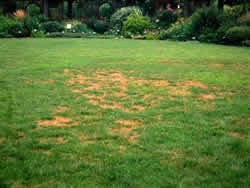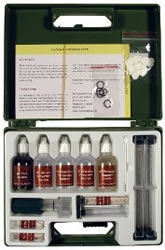No matter how much tender loving care we give to our lawns it is not uncommon to find small and large areas where the grass is not growing well, as shown in Figure 1, or there are bare spots, where the grass is refusing to spread and take root. The best way to bring those lawn areas back with a fresh crop of grass is to apply grass seed to the existing lawn.

Figure 1 - Brown spots on lawn
Planting grass seed to an existing lawn is not an overly difficult project, but if it is not done properly the time and money spent will be wasted.
Follow these steps and you will have the luscious deep lawn that you want, covering your entire yard.
Step 1:
One of the biggest causes of failing grass is poor soil. The soil is the base foundation for any plant to grow and do well and it is no different for grass. Before you do anything else you should test the soil in the areas where the grass is not growing properly. Soil test kits, as shown in Figure 2, are readily available. They will provide you with the soil pH, as well as Nitrogen, phosphorus and Potash content. You can also send your soil to a laboratory for testing, although this is a more expensive option and in most cases the home test kits are more than adequate.

Figure 2 - Soil test kit
I recommend that you test the soil in an area where the grass is thick and plush and then compare those results to an area where the grass isn’t growing well.
If you find that your soil is nutrient deficient or has poor pH I suggest you take the results to a local nursery and have one of their experts tell you the best products to bring the soil nutrients and pH to where they should be.
Note: If you have areas where the grass is not growing due to cat or dog urine, you may have to remove a couple of inches of soil and replace it with fresh soil.
Step 2:
It is important that you choose the right grass seed for your climate, growing conditions and lawn usage.
- Buffalo grass is a warm season perennial grass; a low-water native grass that grows naturally throughout the Great Plains and south into Mexico. Buffalo grass seed is cold and drought tolerant, making it ideal in the areas where water shortage is a true concern or in northern climates where cold can be a problem. Buffalo grass does not do as well in sandy soil and it does not grow well in shaded areas.
- Rye Grass seed is considered a winter grass seed. It is a bunch grass, meaning that it does not send out runners and therefore this makes it a great grass seed to use if you are looking to fill in for a more lush lawn.
- Bermuda grass is a resilient grass that will withstand heavy use. This makes it a great lawn type for families with small children and dogs. Bermuda grass is a warm season grass that loves warm temperatures (grows best at 90-100 degrees!) be sure to plant it in the spring or early summer, not the fall, to ensure the best growth.
If you are in doubt about what grass seed is best in your area and your usage, visit a local nursery.
Step 3:
Rake the area that you want to seed and remove weeds, thatch and small stones. Although some people recommend that you aerate the area to be seeded, personally, I do not think it is necessary.
Additional information of aerating lawns.
If you have clay soil it is best to rake and loosen the top 1/4 inch of soil.
Step 4:
If you are seeding a large area, set your grass spreader for a release of 12 to 15 pounds for 1,000 square feet. Run the spreader over the lawn going North/South and then repeat the process going East/West. This will ensure complete seed coverage.
If you are doing a small area you can sprinkle the seed over the spot by hand.
Step 5:
You should apply a top dressing to the new grass seed. This can be a weed free top soil, manure or organic matter or combination of the three. The top dressing should be no thicker than 1/4 inch over the grass seeds. When raking the top dressing do not inadvertently gather the seeds into one area.
Step 6:
Water! Provide enough water to ensure that the soil around your new grass seeds is always moist at least until germination has taken place. Do not drown the seeds!
